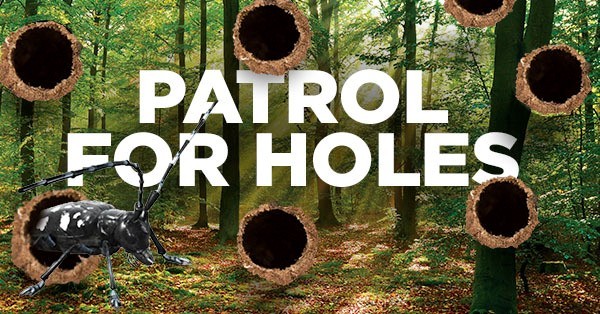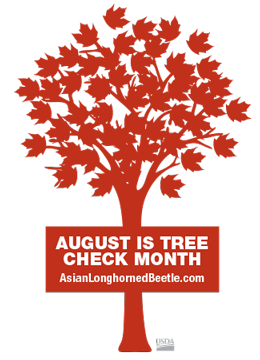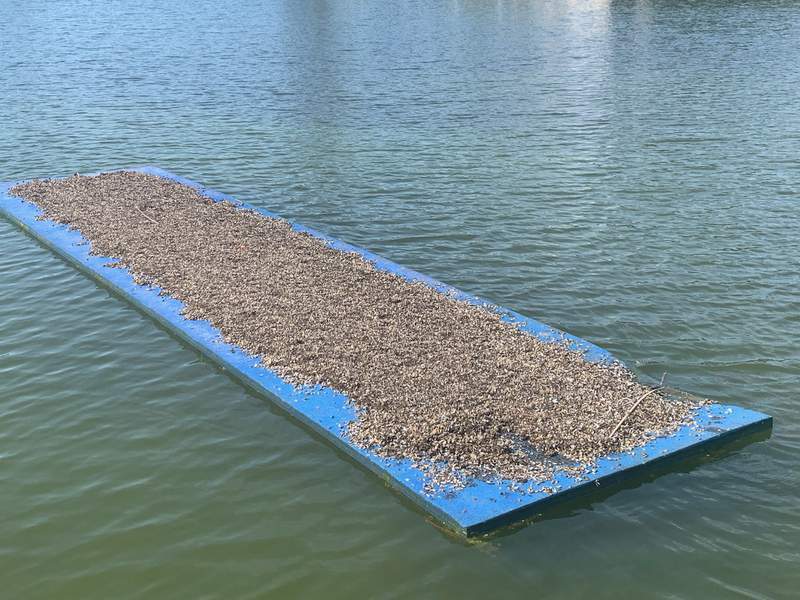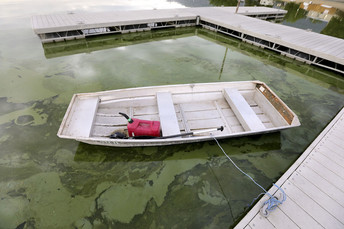|
The Invasive Species Bulletin provides you with all the latest news on invasive species in Montana and the region. Please let us know if you have any suggestions, contributions, questions, corrections, or comments. Email: scriswell@mt.gov

 |
|
WASHINGTON, July 23, 2021 —August is the peak time of year to spot the Asian longhorned beetle (ALB) as adults emerge from trees. That’s why the U.S. Department of Agriculture (USDA) is declaring August as ‘Tree Check Month.’ Checking trees for the beetle and the damage it causes is one way residents can protect their own trees and help USDA’s efforts to eliminate this beetle from the United States. Read more
Resources:
|

Herbicides: What to Know Before You Use Them
When it comes to pesticides, even the ones that sound benign can be dangerous, unless you know what you’re doing.
July 28, 2021 | New York Times
It sounds like the setup for a joke, but it isn’t....When I called Dr. Mangold, I wanted to know: Shouldn’t something this dangerous — yes, the word “danger” was in capital letters on the 30 percent acetic acid label, and on the 20 percent solution — come with detailed consumer guidance?...Read more
|
Kate Wilson and Cassidy Bender of the Upper Columbia Conservation Commission won the Baucus Innovation Challenge at The University of Montana Public Service Academy on August 5. The UC3's efforts in coordination with MT Fish, Wildlife & Parks and the Central Eastern Montana Invasive Species Team to provide AIS outreach to industries across the state took the top prize. The contest challenged attendees of the training to submit a video of an innovative public service program or initiative.
 Department of Livestock Asks Montanans to Stay Alert
June 30, 2021
CONTACT:
Dr. Tahnee Szymanski, MT Dept. of Livestock, (406) 444-5214, tszymanski@mt.gov
Dr. Anna Forseth, MT Dept. of Livestock, (406) 444-2939, anna.forseth@mt.gov
Helena, Mont. - The Montana Department of Livestock (MDOL) is asking residents to remain vigilant about the presence of feral swine. Though there have been no confirmed sightings in Montana, populations are spreading and the risk of introduction to Montana is high.
Feral swine are an invasive species that damage crops, pastures, and waterways, and these animals can carry diseases that spread to livestock, people, and wildlife. The biggest risk of introduction to Montana is swine crossing the border from Canada. Though, with at least 39 U.S. states reporting the presence of feral swine, the risk of illegal imports (intentionally introducing feral swine) for the purposes of hunting, is very concerning.
Montana’s laws defining feral swine include any hog, boar, or pig that appears to be untamed, undomesticated, or in a wild state, or appears to be contained for commercial hunting or trapping. MDOL has received several calls from Montana landowners recently, reporting suspect feral swine sightings, though all have been determined to be privately-owned animals. Read more

Common insecticide is harmful to bees in any amount
For the average bee, every little bit counts
ScienceDaily | August 2, 2021
The dangers of neonicotinoid insecticides likely can't be watered down. That's the conclusion of a new study showing an insecticide made for commercial plant nurseries is harmful to a typical bee even when applied well below the label rate and the plant receives high levels of irrigation. Read more
|
Control weeds to improve forage
The News Enterprise | August 3, 2021
Weeds can reduce the quantity and the stand life of desirable forage plants in pastures and hayfields.
These unwanted plants often are more aggressive than existing or desired forage species and compete for light, water and nutrients. Weeds also can diminish the quality and palatability of the forage available for livestock grazing and certain weed species are potentially poisonous to grazing animals. The aesthetic value of a pasture also is impacted by weeds. Read more
Wild pigs are one of the most widespread invasive species on Earth. Image credit: Fitzroy Basin Association
The climate impact of wild pigs greater than a million cars
University of Queensland Australia News | July 20, 2021
By uprooting carbon trapped in soil, wild pigs are releasing around 4.9 million metric tonnes of carbon dioxide annually across the globe, the equivalent of 1.1 million cars.
An international team led by researchers from The University of Queensland and The University of Canterbury have used predictive population models, coupled with advanced mapping techniques to pinpoint the climate damage wild pigs are causing across five continents. Read more
 |
|
Feral Fight: Humane bait for killing feral pigs
A fast acting, humane poison bait is being hailed as a major break-through in feral pig control.
Landline with Pip Courtney
Watch video
|
In the absence of genetic variation, asexual invasive species find new methods of adapting to their environment
Science Daily | July 30, 2021
Without the benefits of evolutionary genetic variation that accompany meiotic reproduction, how does an asexual invasive species adapt over time to a new environment to survive? In all-female weevil species that produce only female offspring from unfertilized eggs, the insects' survival techniques have led to the surprising discovery that these creatures can pass down gene regulation changes to future generations. Full story
 Zebra mussels on the bottom of a float at Lake Lyndon B. Johnson (KSAT 12)

Many of Utah’s reservoirs are struggling with more than just low water levels. Harmful algal blooms have blanketed Utah Lake, resulting in a health advisory, and Scofield Reservoir is under a danger advisory because of the high density of toxins.
Algal blooms are pictured in Utah Lake at the Lindon Marina in Vineyard on Monday, July 19, 2021. Kristin Murphy, Deseret News
|
More News
Montana Ag Alert: MSU Extension Drought Resources in Montana
On July 1, 2021, Governor Greg Gianforte issued an executive order declaring a statewide drought emergency in Montana. The U.S. Drought Monitor indicates 98.7% of Montana faces drought conditions as of July 29. Approximately 49% of the state is in either D4 (exceptional drought) or D3 (extreme drought), 31% in D2 (severe drought), and 19% in D1 (moderate drought). Conditions are expected to worsen over the next eight to ten weeks. Conditions are forcing agricultural operations to make difficult decisions due to high nitrates in forage, contaminated and limited water sources, lack of forage for livestock, insect infestations and many other related issues. This Ag Alert is a reminder of the many resources through MSU Extension that are available to assist individuals making difficult drought decisions across multiple disciplines.
TechLine Invasive Plant News: Herbicides Role in Balanced Landscapes: Controlling Weeds and Maintaining Desirable Vegetation
Efforts to prevent invasive aquatic species like zebra and quagga mussels in Montana waters are ramping up as the state just broke the record for the amount of mussel-infested boats intercepted at check stations—and that was before July 1.
Hot temperatures accelerating the spread of invasive species [lnks.gd]
July 19, 2021. Scientists say the extreme heat can accelerate the spread of invasive species by altering their life cycles and their ability to spread into new areas.
Confer: EPA and corporations must do better against invasive species [lnks.gd]
July 20, 2021. One could argue that invasive species, not warming temperatures, are the greatest threat posed to natural balance in North America. Animals and plants that don’t belong in our country but have ended up taking root, destroying our resources in perpetuity.
Wyoming Game and Fish Department focuses on preventing invasive zebra and quagga mussels from reaching state’s waters [lnks.gd]
July 25, 2021. Staff at Wyoming’s Game and Fish Department are laser focused on preventing Zebra mussels and quagga mussels, two types of aquatic invasive species (AIS), from reaching Wyoming’s waters, where they are likely to quickly proliferate.
Scientists are renaming the ‘gypsy moth’ as part of broader push to root out offensive monikers (7/11/21) [washingtonpost.com]
The fluttering bug known as the “gypsy moth” is in the market for a new name after the world’s largest organization of insect experts announced it would stop using the moniker because it contains an ethnic slur.
The Entomological Society of America’s recent announcement is part of a broader discussion within the scientific community about equity in naming. Ornithologists are grappling with whether to change the names of birds that commemorate enslavers and supremacists. Schools and buildings named after eugenicists are searching for new innovators to claim.
The decision to rename both the “gypsy moth” and the “gypsy ant” coincides with the launch of the organization’s Better Common Names Project [entsoc.org]. Though the change is specific to the society and its publications, it’s anticipated to ripple outward.
State to trap Asian giant hornets in Whatcom County. Citizen-scientist trappers are welcomed (6/1/21) [bellinghamherald.com]
Early Estimates of Exotic Annual Grass (EAG) in the Sagebrush Biome
The U.S. Geological Survey’s Rangeland Exotic Plant Monitoring System team announces the release of its dataset “Early Estimates of Exotic Annual Grass (EAG) in the Sagebrush Biome, USA, July 2021”. The spatially-explicit dataset used satellite imagery up to June 28th, 2021, to provide an early look at exotic annual grass abundance across much of the sagebrush biome in the western U.S. The dataset was developed at a 30-meter spatial resolution and is publicly available [doi.org] in the ScienceBase repository. This is the second of two planned releases of EAG abundance for the 2021 year, and includes separate maps each of estimates of cheatgrass and medusahead across the study area.
USDA Statement on Confirmation of African Swine Fever in the Dominican Republic
The U.S. Department of Agriculture’s (USDA) Foreign Animal Disease Diagnostic Laboratory has confirmed African swine fever (ASF) in samples collected from pigs in the Dominican Republic through an existing cooperative surveillance program.
The NAISMA Board of Directors is an active, engaged group. Board members are being sought to fill four (4) open positions for 2021. The deadline to nominate is August 24. NAISMA’s Board of Directors represent a breadth of invasive species management and research skills and perspectives from across North America.
Click here to learn more.

Preventing Weed Invasion from Hay Shipments
As drought continues to worsen and forage is scarce, a lot of hay is moving from one place to another, which poses the risk of introducing new weeds and other pests. The August Weed Post [msuinvasiveplants.org] discusses short- and long-term practices for preventing weed invasion from hay shipments. Along with other resources that may be helpful. One is an ad to be used through social media channels (thank you, Shantell Frame-Martin) and the others were prepared by NRCS (thank you, Monica Pokorny). Please share this information far and wide.
This outreach effort is a partnership between the Montana Department of Agriculture, Montana Invasive Species Council, Montana’s Natural Resources Conservation Service, Montana Weed Control Association, Montana Noxious Weed Education Campaign, and MSU Extension.
Social Media Ad
NRCS Fact Sheet
NRCS Invasive Species Resources
|
Montana Watershed Conservation Corps members continue to share invasive species information
Aug 15-18, Big Sky, PNWER Conference, Jennifer (FWP)
Aug 26, Stanford Fairgrounds, Judith Basin Conservation District's Natural Resource Day, Colin (CEMIST)
Aug 28, Craig, Caddis Festival, Colin (CEMIST)
Sept 11, Lewistown, Chokecherry Festival, Jennifer (FWP) & Colin (CEMIST)
Sept 27-30, Missoula, NAISMA, CEMIST, UC3, & FWP
 |
|
2021 NAISMA ANNUAL CONFERENCE
Transboundary Cooperation
|
CALL FOR ABSTRACTS — 22nd International Conference on Aquatic Invasive Species
April 18-22, 2022 [Hybrid conference with in-person and live virtual components]
Thermae Palace Hotel, Oostende, Belgium
Abstract submission deadline September 30, 2021. The theme of ICAIS 2022 is to demonstrate the interconnectedness of global invasive species issues and inspire international collaboration on research projects at a global scale.
Events
Aug. 15-19, Pacific NorthWest Economic Region Summit, Big Sky
Sept. 15-16, NW Regional Invasive Species & Climate Change Symposium, virtual
Sept. 20-24, WRP Annual Meeting, virtual
Sept. 22-23. Hands-on Integrated Pest Management Workshop on Soil Health. Montana State University, Bozeman
Sept. 27, Feral Swine Transboundary Workgroup Meeting. Contact scriswell@mt.gov for more information, Missoula
Sept. 27-30, North American Invasive Species Management Association Conference co-hosted with MISC, Missoula
Oct. 6-7, Invasive Species Council of BC 2021 Invasive Species Research Conference, virtual
Oct. 31-Nov. 3, Entomological Society of America, hybrid, Denver, Colorado
Nov. 29-Dec. 2, Innovations in Invasive Species Management Conference and Training, Nashville
Feb. 28-March 4, 2022, National Invasive Species Awareness Week
April 18-22, 2022, 22nd International Conference on Aquatic Invasive Species, Thermae Palace Hotel, Oostende Belgium
Webinars
NAISMA
August 18, 1 p.m. CT - Racial Equity & Environmentalism [us02web.zoom.us]
September 15, 1 p.m. CT - Flowering Rush Biology, Management, and Control
October 20, 1 p.m. CT - Forestry BMPs for Invasive Species [lnks.gd]
U.S. EPA IPM webinars - Usually 90-minute programs focused on different IPM topics.
U.S.Geological Survey Aquatic Species Database Seminar Series
The U.S. Geological Survey's Nonindigenous Aquatic Species Database
presents a seminar series focused on providing undergraduate students
and early career scientists insight into federal career options as well as
how various federal agencies work on invasive species issues nationwide.
Learn how various federal agencies contribute to the management and research of
invasive species. Hear what opportunities those agencies provide for students 2021 Summer Student Seminar Series. For more information click here.
Webinar Recordings
The IMP Hour monthly online seminars
Funding Opportunities
DNRC and MISC accepting AIS Grant Application
Click here for more information.
Up to $50,000 is available per project to Montana communities or local, state, tribal, or other entities within the state and to Montana-based non-governmental entities.
Applications are due Wednesday, November 5, 2021, by 5 pm.
NEW this cycle:
DNRC is transitioning from WebGrants to Submittables and this change will make it easier to complete and manage your application online. Grantees will be able to complete reports, send notifications, and track and edit submissions. Click here to create an account and here to watch a video on how to get started with Submittables. To apply click here.
MISC has established permanent dates for the annual AIS grant cycle.
Application cycle opens: Annually in late summer (8/1/21)
Application cycle closes: 1st Wednesday in November by 5 p.m. (11/3/21)
AIS Grant Hearings: 2nd Wednesday in January (1/12/21)
|
|
|
|
Funding Available to Support Areas, Industries and Crops by Documenting Pest Management Needs
Funding: Up to $15,000 per award
Details: These grants can be used to produce Pest Management Strategic Plans, Crop Profiles or other IPM-related plans. $75,000 is available in the 2021 cycle.
Applications considered on a rolling basis until funds are exhausted.
Resources to get you started:
Western PM Center Planning Document Request for Applications - The way to apply for our grant funding.
Guidelines for Producing a Pest Management Strategic Plan - This is the traditional approach to these documents.
Guidelines for Producing an Integrated Pest Management Strategic Plan - This is new approach to writing a PMSP that focuses more on IPM principles
If you have questions or want to know more, email Western IPM Center Director Matt Baur.
2022 BSWC Host Site Cost Share Funding For Conservation Districts
Montana Association of Conservation Districts, in partnership with NRCS, is offering five (5), $6,125.00 awards, totaling $30,125.00, towards the cost of a Big Sky Watershed Corps (BSWC) member for the 2022 term of service. These awards are prioritized for Conservation Districts interested in hosting a BSWC member. There is a required 50% non-federal match associated with this award. Click here for more information: BSWC 319 Host Site Cost Share Support
Deadline:
Job Opportunities
MT FWP Watercraft Inspectors, various locations. Visit State of Montana Careers and keyword search "watercraft inspector." Ongoing
|